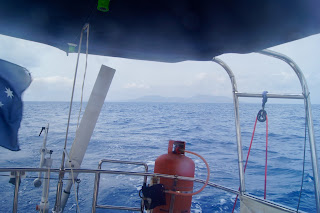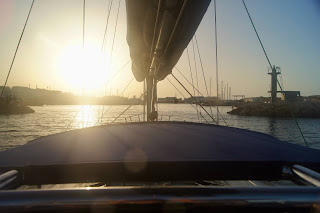This is a technical post! It describes the methods blue-water cruisers use for long-range communication between themselves and to keep in touch with the outside world. I wrote it recently for the Bluewater section of the Cruising Association. You can view it on their website here (login required).
 |
| WinLink Coast Station Network |
HF/SSB (High Frequency/Single Side Band) and satellites are the two ways of achieving long range (beyond line of sight) communication. The former uses the ionosphere. The latter uses communication satellites as intermediaries.
Our blog includes a number of technical posts including HF/SSB, satellite communication and many other topics. You can search for content using the "Search this Blog" box at the top left of this page or the "Word Cloud" on the right (eg HF or SatCom). Alternately use these links:
HF/SSB
Marine HF/SSB radios are used to keep in touch directly with other cruisers, to access email and to obtain weather information. A GMDSS DSC-equipped marine HF/SSB provides long distance distress and safety communication with coast stations, ships and potentially other yachts in an emergency.
HF/SSB radios require proper installation with an antenna tuner to a back stay or whip antenna and an effective ground. Installation can significantly add to the cost. Careful attention must be paid to initial testing and ongoing maintenance. HF/SSB optimisation often takes time and experimentation and this can’t be done effectively in a marina.
HF/SSB radios are designed to run on 12V DC power. Transmit power consumption is high (around 30A), requiring careful installation with minimal connections. However transmission is usually for short periods and so consumes few AmpHours. In contrast receive power consumption is 1A to 2A and so consumes significant AmpHours if run continuously. This impacts on marine HF/SSB DSC routine calling since few cruisers have their radios running continuously.
Marine HF/SSB radios can receive over the full LF/MF/HF range (100kHz to 30MHz) but limit transmission to marine bands. This limit can be overridden on most radios. Transmitting on amateur bands requires an amateur licence. Transmitting on other bands (eg aviation, military etc) is forbidden except in emergency.
 |
| Zen Again's previous Icom M802 Marine HF/SSB |
Marine HF/SSB radios are designed and built to high standards imposed for marine communication. Amateur HF/SSB radios are less expensive, just as capable and can be more fun to use. But they do NOT meet the marine standards. Therefore marine HF/SSB radios are allowed to transmit on amateur bands, but amateur radios must NOT transmit on marine bands. The extent to which this is enforced appears limited, particularly mid-ocean and in remote areas. Many blue-water boats fit amateur HF/SSB radios.
Selection of frequency and time of day are vital to successful use of HF/SSB. This is due to the dynamic nature of the ionosphere which delivers (or removes) long range HF propagation. Low cost software is available to predict the best frequencies and times of day for communication between nominated locations.
Keeping in Touch
Many cruisers keep in touch with other cruisers via SSB ‘nets’ or ‘skeds’. These are simply an agreement to meet on a given frequency at a given time. They range from informal nets between pairs or groups of boats to more formal nets, some of which are run by coast stations. For example the ARC organisers run nets for participants to report position and weather, and to allow participants to chat afterwards.
Groups of cruising boats embarking on ocean passages often arrange a daily net to keep in touch. They allow the exchange of safety information and social chat which can be a highlight of the day. Nets are sometimes followed by a kid’s net, where younger cruisers can catch up with their pals.
Net control is often handled by the boat with the best radio installation. The controller first requests any safety traffic then asks each participant for their report in turn, logging key information. Each report includes the boat position, their status, plus perhaps weather and a daily highlight. Positions should be stated slowly and clearly, and NOT contain decimals of minutes.
Email
Email can be sent and received via HF/SSB. For non-amateur license holders this requires a Pactor hardware modem, Airmail PC software and (most commonly) a subscription to the SailMail global network of coast stations. Amateur licence holders can use a Pactor modem or a software modem embedded in PC software to access the Winlink global network of coast stations.
The email data rate is similar to that achieved using a satellite phone, being hundreds of bytes/second. Data rate varies dynamically with HF propagation conditions. Sensible frequency and time of day selection is important. Attachments such as GRIB files are supported, allowing the reception of weather GRIB data from services such as SailDocs.
RadioFax, RTTY and Shortwave
Radio facsimiles of weather, ice and other information are transmitted from a shrinking set of coast stations around the world. A RadioTeletype (RTTY) weather service is also provided in some areas. Shortwave broadcast stations all around the world allow blue-water cruisers to monitor news mid-ocean. These services require only a SSB receiver. Radiofax and RTTY are decoded using low cost software available for PC and tablets.
Amateur (Ham) Radio
Amateur radio operators are licenced following completion of a training course. Courses are run by amateur radio clubs. Licenced amateurs can communicate with other amateurs across the world. They can use voice, CW (morse) and data in designated amateur frequency bands which span MF, HF and beyond. This opens up a global network of contacts useful for both routine and emergency traffic. Licenced amateurs can join the free Winlink email service and take part in amateur nets.
 |
| Zen Again's current Icom IC-7300 Amateur HF/SSB |
Several nets are run by groups of amateur coast stations. An example is the Maritime Mobile Net on 14300Hz. Some of the coast stations have rotatable directional antennas, very high transmit power and very sensitive receivers. These nets provide safety coverage over very wide areas.
Amateur bands below 10MHz use LSB (Lower Side Band) for voice – unlike marine bands which use USB (Upper Side Band) regardless of frequency. There are no predefined voice channels in amateur bands, one simply picks a free frequency within an amateur band. CW is usually found at the lower frequencies in each band, then data, then voice at the higher frequencies. Amateur nets run on published frequencies.
Satellite
Most blue-water cruisers carry one or more satellite devices. These range from simple messaging devices to email-capable satellite phones to internet-capable broadband satellite terminals. Portable satellite devices run on their internal batteries and so can be used in a liferaft, unlike a HF/SSB.
Satellite devices generally allow voice communication between two parties. This is fundamentally different to HF/SSB where anyone within range can take part in a conversation (eg a net). Hence HF/SSB is more social. Satellite devices and services are rapidly evolving and are easier to use.
Satellite Messaging Devices
These devices are inexpensive and simple to use. They provide a means of sending and receiving short messages. They include a GNSS receiver, allowing position to be transmitted with each message. These positions can be used to create a web page showing your track. Many include a (non GMDSS) emergency function. They use a built-in antenna.
Satellite Phones
These devices provide voice, text and many are also data capable. Data rate is hundreds of bytes/second which is sufficient for email but not for internet browsing. The most common use of satellite phones is for email, including accessing weather GRIB files.
These devices can use either their built-in or an external antenna. For data use the external antenna is recommended. The external antenna is omnidirectional and usually no larger than a coffee mug.
 |
| Iridium Go! |
A popular satellite phone is the Iridium Go!. This unit provides a WiFi hotspot to which smart phones and tablets can connect to use voice, text and email. PC software such as Airmail, Winlink, XGate and PredictWind’s Offshore app can control the Go! to access email and/or download weather information. The Go! incorporates a GNSS receiver for tracking purposes. The GNSS antenna is built into the base unit - it isn't in the external antenna!
Broadband Satellite Terminals
These devices provide broadband data rates and provide voice, text, email and full internet browsing. Until recently they have required large mechanically-stabilised antennas. Newer units use electronic ‘beam steering’ antenna technology which do not require stabilisation and are smaller. These systems remain expensive to buy and expensive to run.
New satellite constellations such as StarLink may soon offer broadband at similar cost to satellite phones. This may revolutionise safety at sea by allowing real-time traffic, weather and ocean surface current viewing. It is not yet available.
























































